Reviewer's Note: The Quark MiNi lights were provided for review by 4Sevens.com. Please see their website for more info.
UPDATE May 27, 2010: For a discussion of the possible tint options for the Mini line (i.e. Cool White, Neutral White, Warm White), please see my new Mini Tint Comparison Review.
UPDATE May 28, 2010: A separate review of the new Mini CR2 has just been posted.
Warning: Even more pic heavy than usual. oo:
oo:
Manufacturer's specifications, condensed from their 4sevens.com:
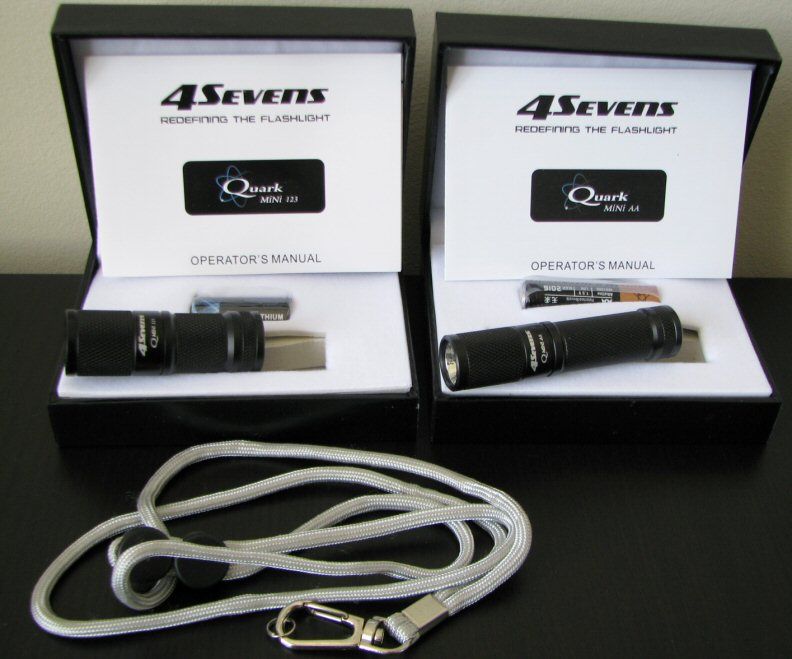
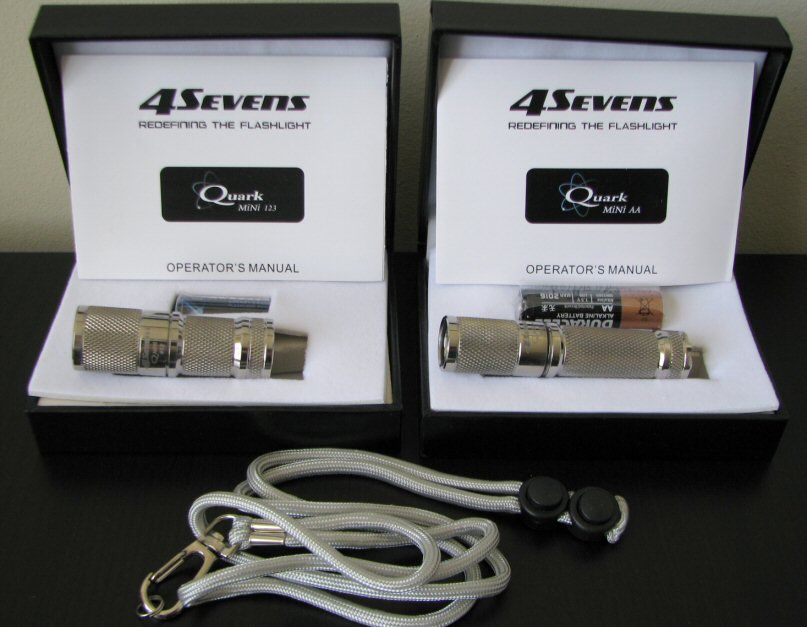
Each light comes in an identical good-quality presentation case, similar to a medium-sized jewelery box (i.e. solid lid with hinge). Inside, you find the light well packaged inside white cut-out foam, along with a battery (Duracell AA or 4Sevens CR123A, as appropriate), good quality wrist strap/lanyard, and manual
To keep this simple, I will alternate between representative pics of the various samples below. Construction is generally equivalent between all the specimens, so my comments apply equally to each member of the Mini family. This will save me from having to take a gazillion photos ... :sweat:
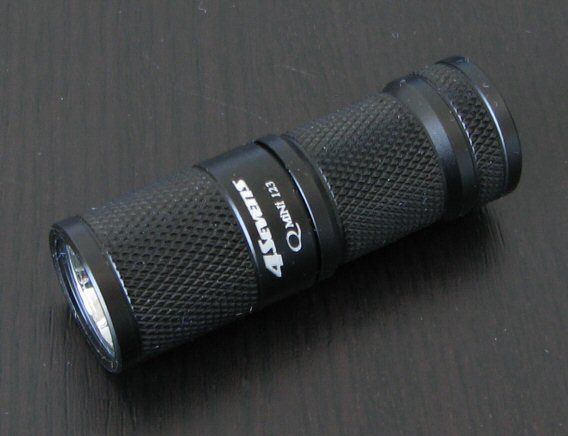
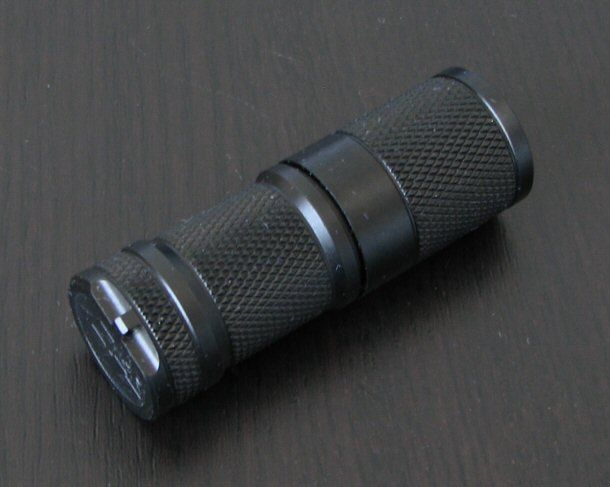
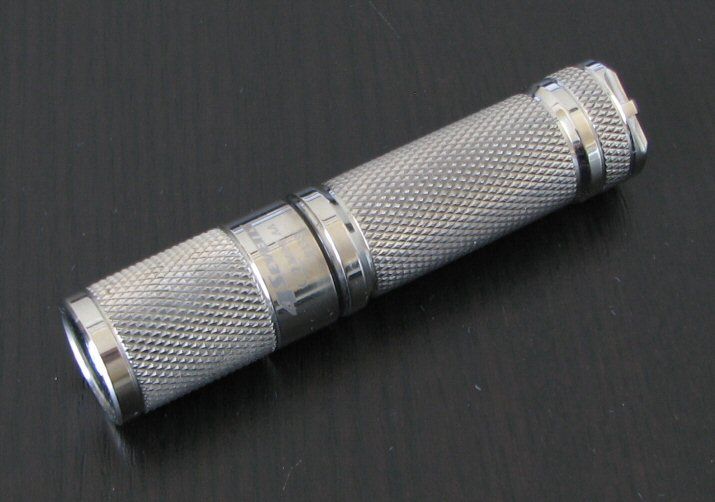
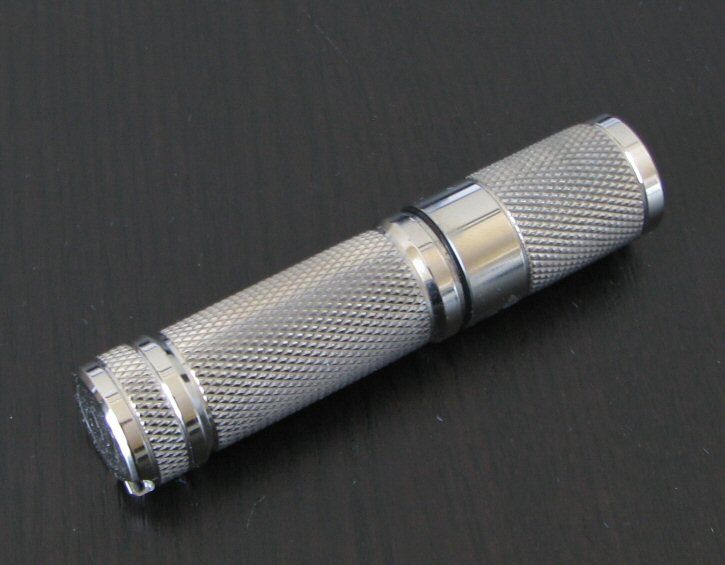
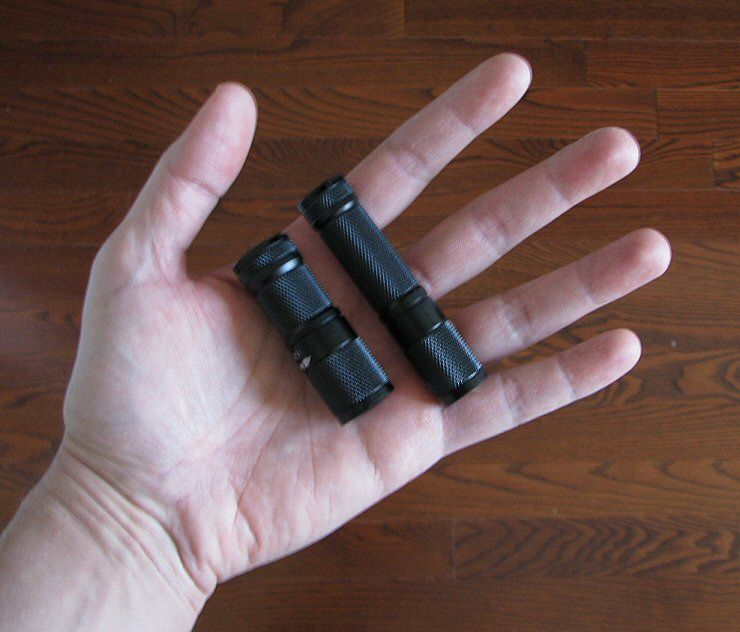
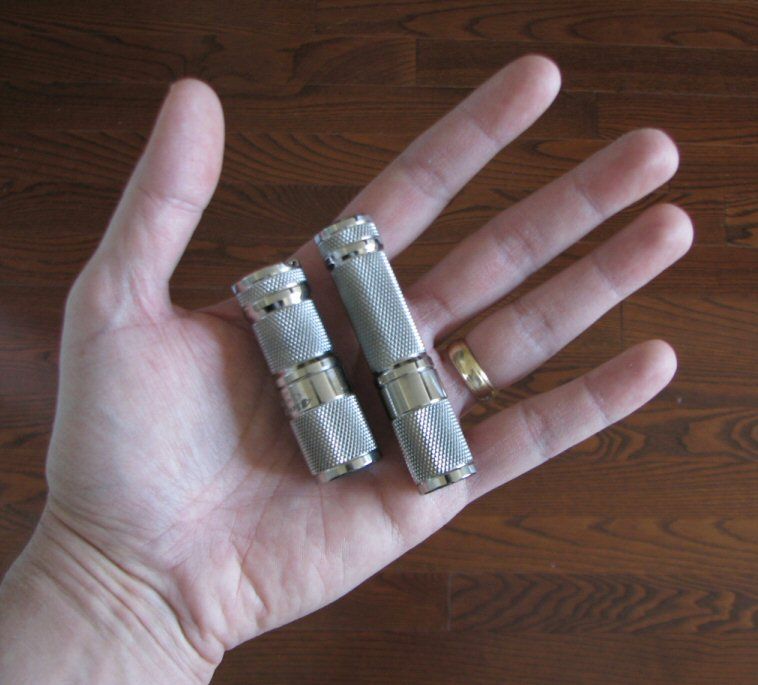
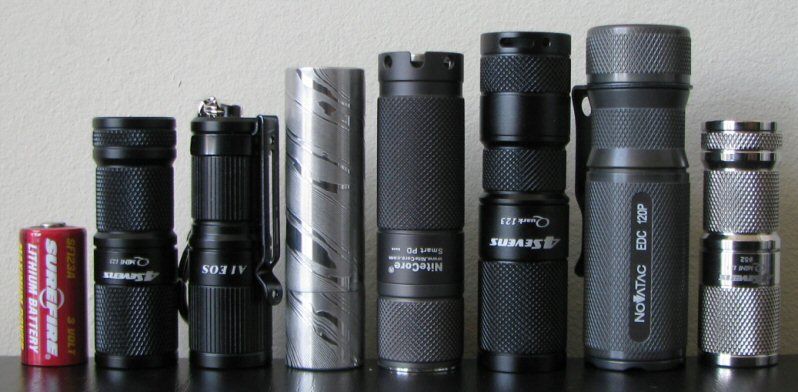
From left to right: Surefire CR123A, 4Sevens MiNi 123, ITP A1, NaitHawk Dear 123, Nitecore EX10, 4Sevens Quark 123, Novatac 120P, 4Sevens MiNi Titanium 123.
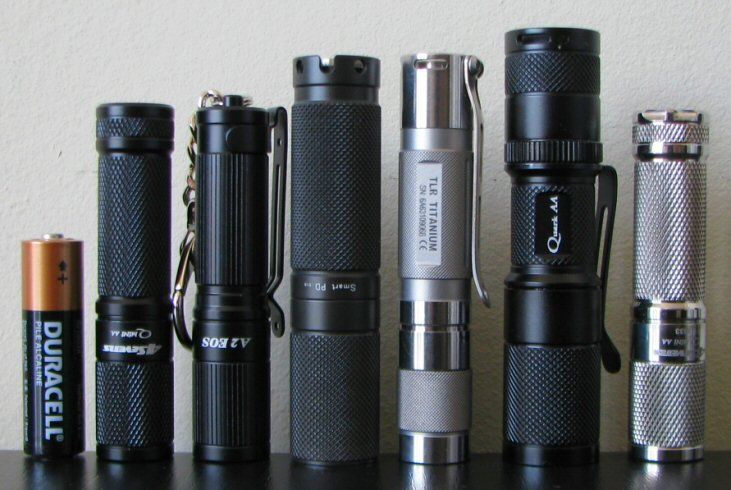
From left to right: Duracell AA, 4Sevens MiNi AA, ITP A2, NiteCore D10, DST TLR Titanium, 4Sevens Quark AA, 4Sevens MiNi Titanium AA.
As you can see, the lights are indeed quite small for their respective classes. Basically, you don't get much smaller than this! Like the popular 1xAAA series 4Sevens Preon and ITP/Maratac lights, the aluminum body construction seems thin (i.e. body walls), but is still serviceable. The titanium versions are of course more sturdy, due to the source material used.
The Minis have the advantage of generous knurling, which makes it easier to use the twist feature one-handed. :thumbsup: Knurling is fairly aggressive – on both the aluminum and titanium versions. I didn't notice any chips or damage in the finish on any of my samples. The finish of the titanium versions is somewhat shiny (i.e. high gloss polished).
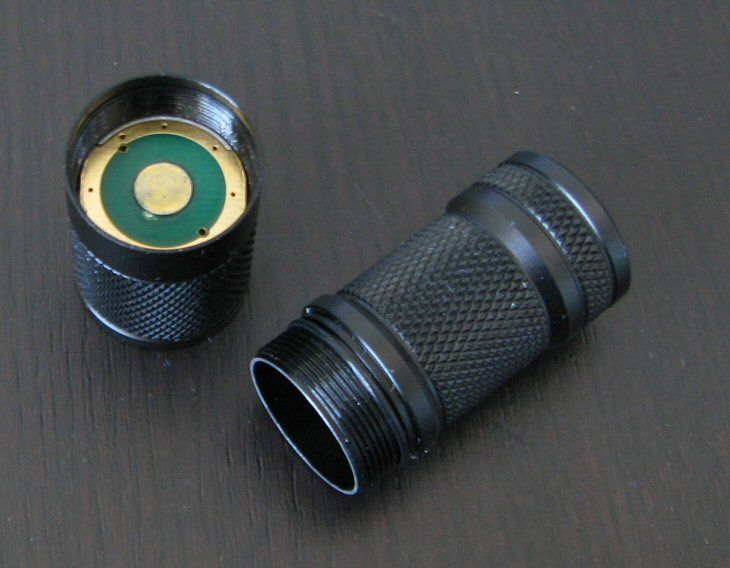
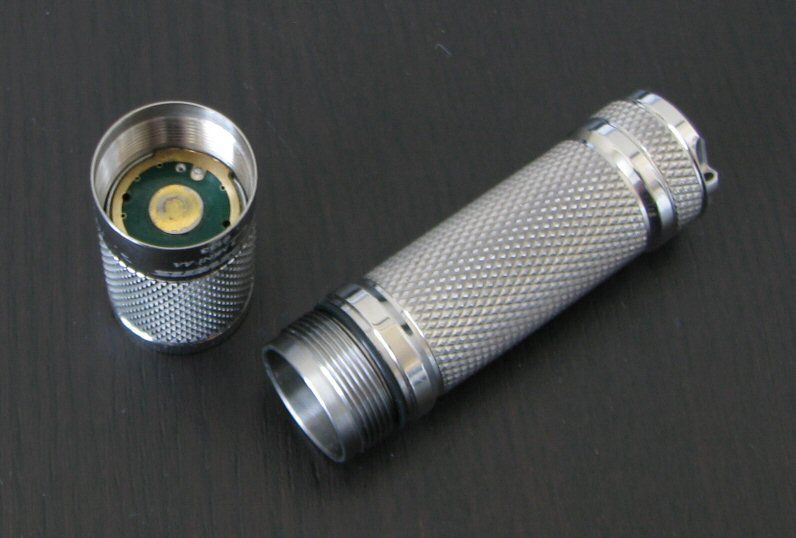
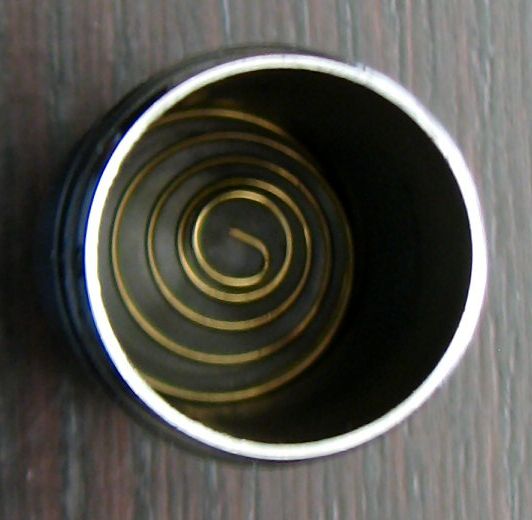
In keeping with the minimalist build, the head has a simple contact board (which just happens to look an awful lot like the ITP A1/A2 ... ).
).
Note that the threads were somewhat "gritty" on several of my samples. Although this didn't interfere with operation, I recommend you clean them thoroughly upon arrival (and maybe even apply a small amount of a good quality non-conducting lube). Note also that titanium lights typically suffer from some degree of "galling" in the screw threads (i.e. a sticky/binding sensation - this is normal).
The lights all use a removable spring for the negative contact, which should reduce the risk of accidentally crushing a cell. :thumbsup:
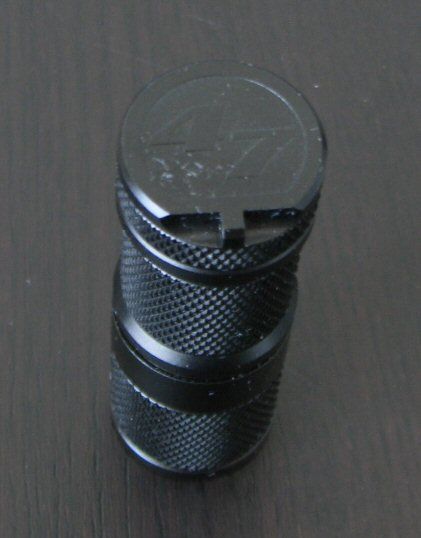
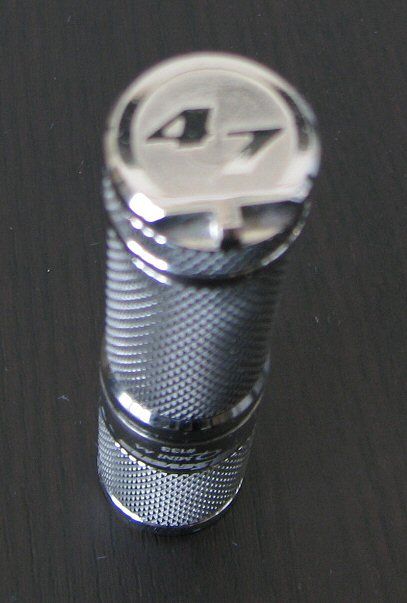
The lights can tailstand, and there is thoughtfully an attachment point for a lanyard. :thumbsup:
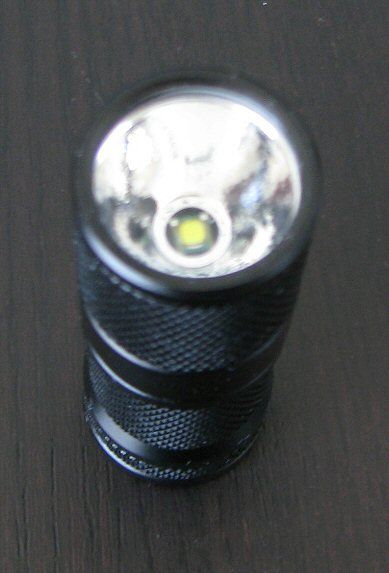
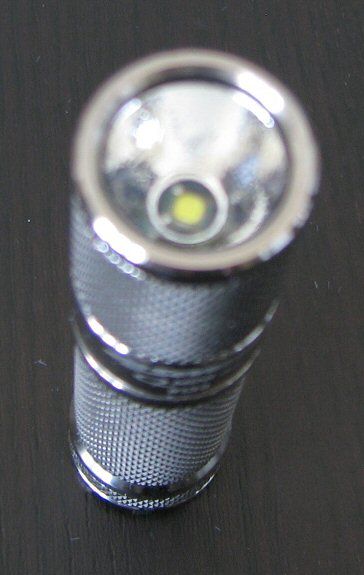
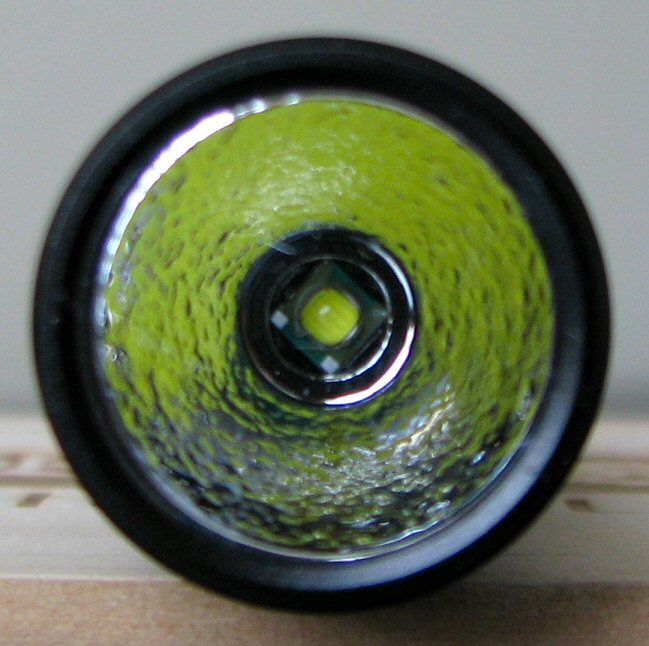
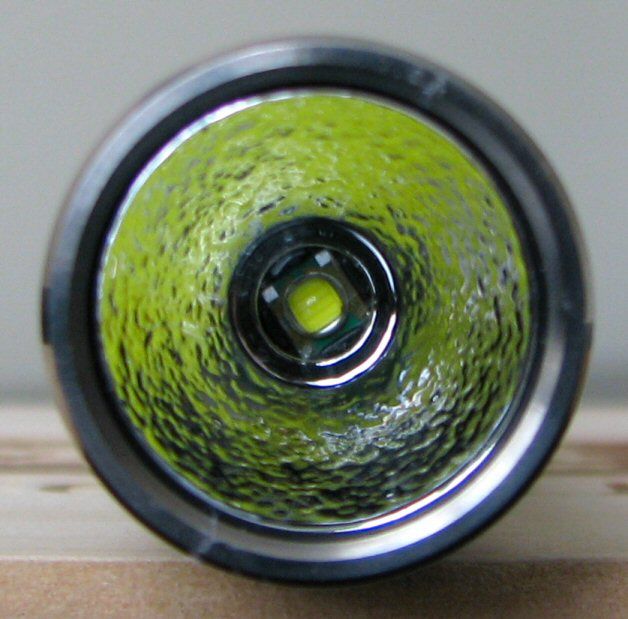
The lights feature one of the latest edition Cree emitters - the XP-G (R5 output bin, no tint bin specified). Reflector is not overly deep, but heavily textured.
And now for the requisite white wall hunting . To begin, here are the 1xCR123A lights on Max with on AW RCR, about 0.5 meters from a white wall:
. To begin, here are the 1xCR123A lights on Max with on AW RCR, about 0.5 meters from a white wall:
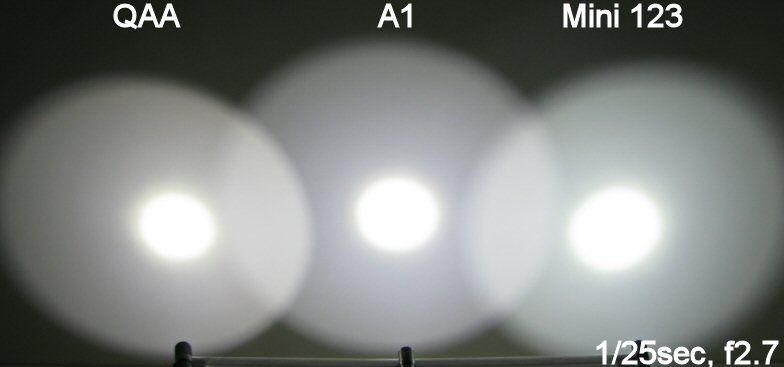
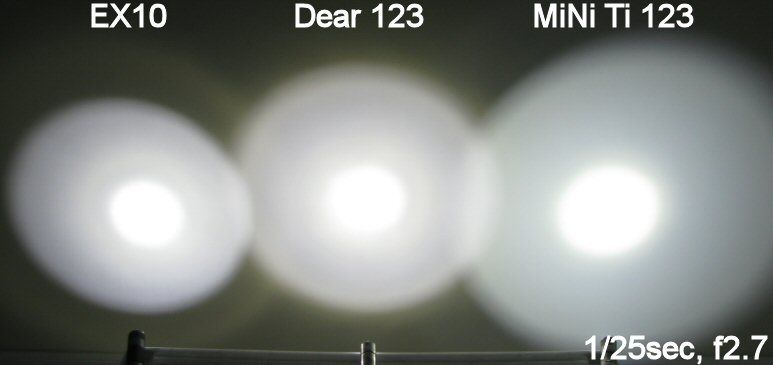
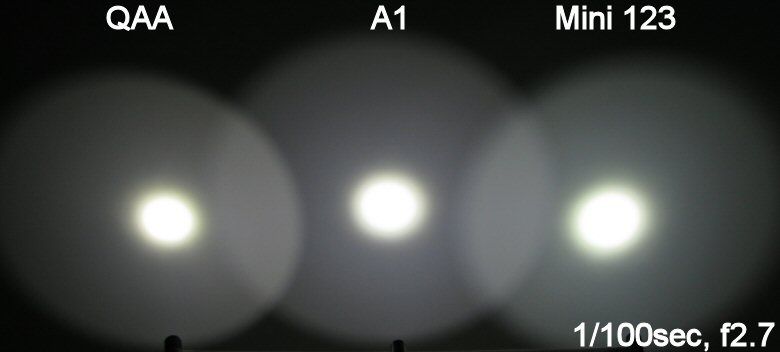
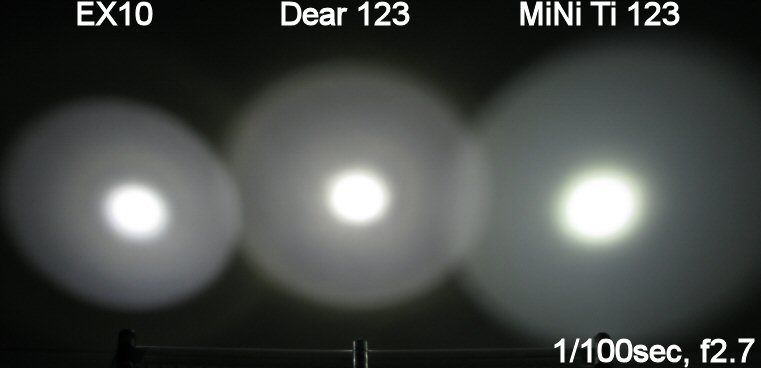
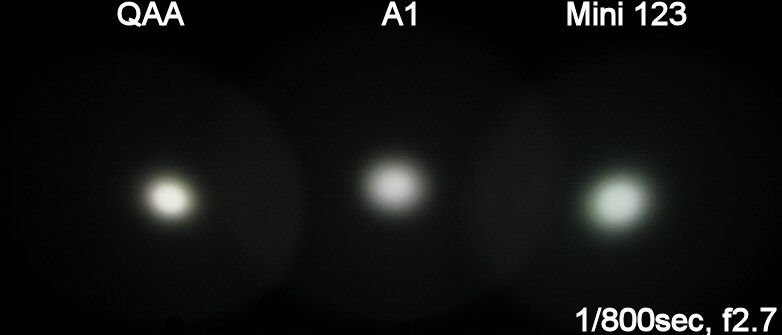
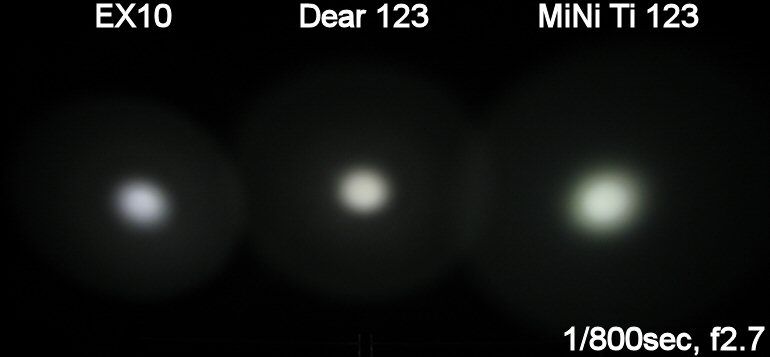
And now the 1xAA lights, on Sanyo eneloop, about 0.5 meters from a white wall:
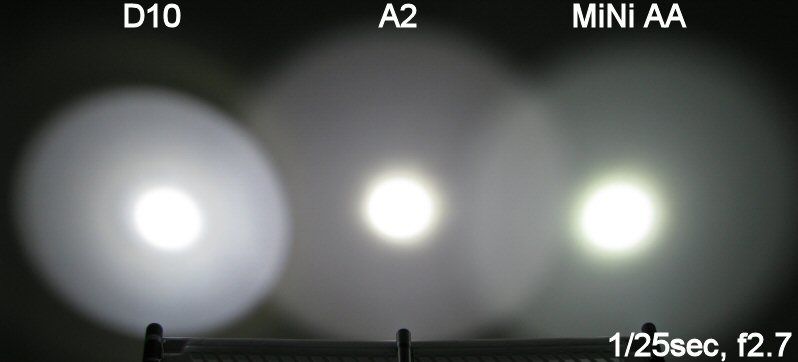
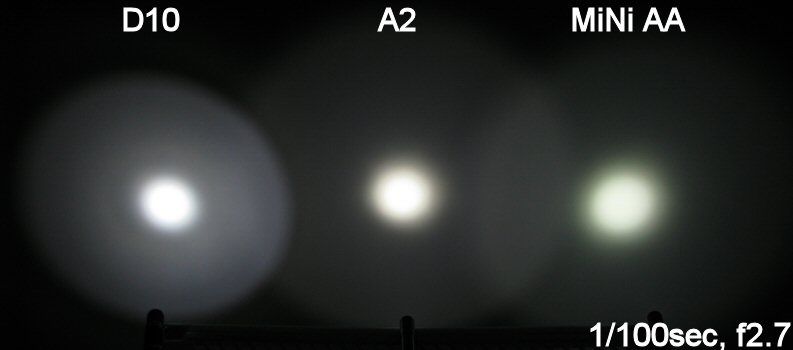
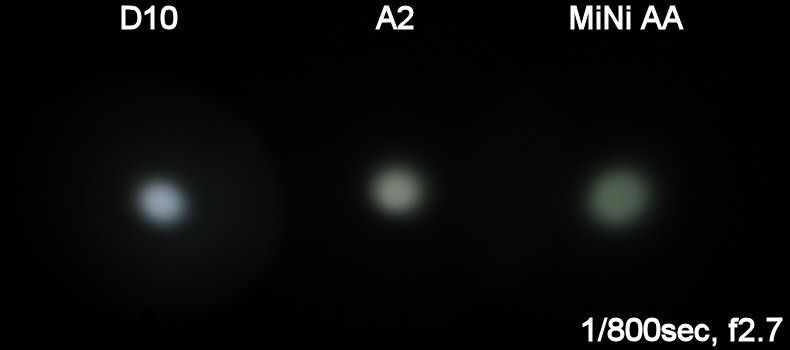
As expected, beam pattern is fairly good for a general purpose light. Don't expect massive throw from an XP-G. Tint was generally slightly on the yellow-green side of cool white (i.e. not a premium output bin). :shrug: For those of you not familiar with tint bins, please see my Colour tint comparison and the summary LED tint charts found here.
As an aside, you will note the strong beam pattern similarity to the ITP A1/A2 lights. It's a little more than that – if you check out my review of those lights, you will see they share an almost identical build with the Minis. Sure, the Minis have a different lanyard attachment and aggressive knurling, but the difference to the A1/A2 is very much similar to the Maratac compared to the ITP A3. In fact, the head/body tubes are interchangeable between the Minis and ITP A1/A2 …
UPDATE: Note that the standard Cool White Minis are shown above. For a discussion of the possible tint options for the Mini line (i.e. Cool White, Neutral White, Warm White), please see my new Mini Tint Comparison Review.
User Interface
The Minis use the same interface as the AAA 4Sevens Preons. In their standard operating mode, they are very similar to other budget lights (e.g. ITP/Maratac), and use a Lo > Med > Hi mode sequence. However, like the Preons, the Minis have a few additional tricks up their battery tubes ….
Basic operation is controlled by twisting the head tight against the body to activate the light, loosen to turn off. Do a twist off-on in under 1 sec and the light advances to its next mode sequence. Wait more than two seconds before re-activating the light after turning off, and it returns to default Lo (i.e. no memory mode).
There is no strobe or SOS mode to worry about in the regular interface. :kiss: But like the Preons, they are "hidden" away if you want them. Normally, twisty-mode cycle selection continues indefinitely - keep doing off-on twists to run through all the sequences in order again. But if you run through the complete sequence twice in under two seconds (i.e. On Lo > Med > Hi > Lo > Med > Hi), you will access the additional hidden modes. These present themselves in sequence as Strobe > SOS > Hi Beacon > Lo Beacon.
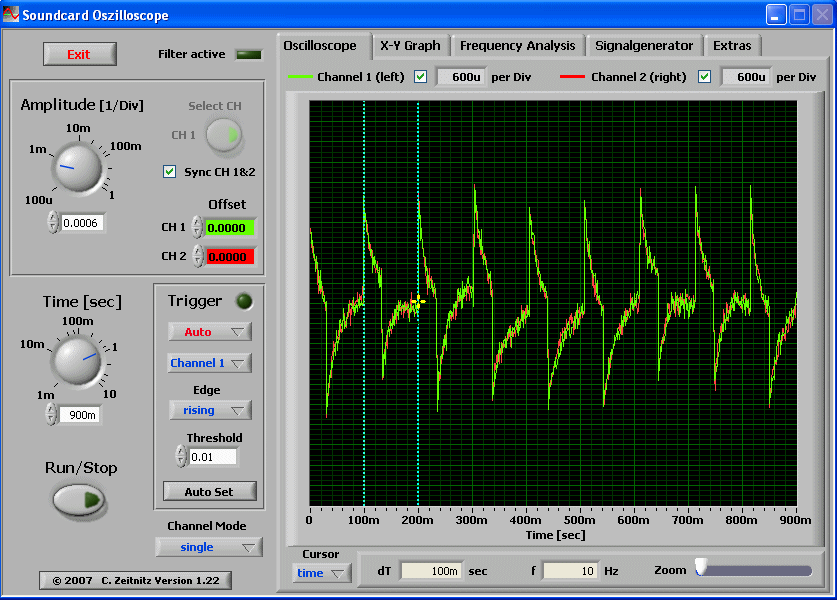
Like the Preons, strobe was measured at 10Hz. Beacon modes are 5 rapid flashes followed a single ~1.25 sec flash at 10 sec intervals, at either full power (Hi) or lower power (Lo).
Note that there is no memory for "special outputs" either – if you turn off the light for more than 2 seconds, you will be back at constant output Lo when next you re-illuminate. So no worries about getting stuck accidentally strobing yourself here. :thumbsup: Frankly, this is the sort of interface I like to see – "special modes" are well hidden, and not at all obtrusive.
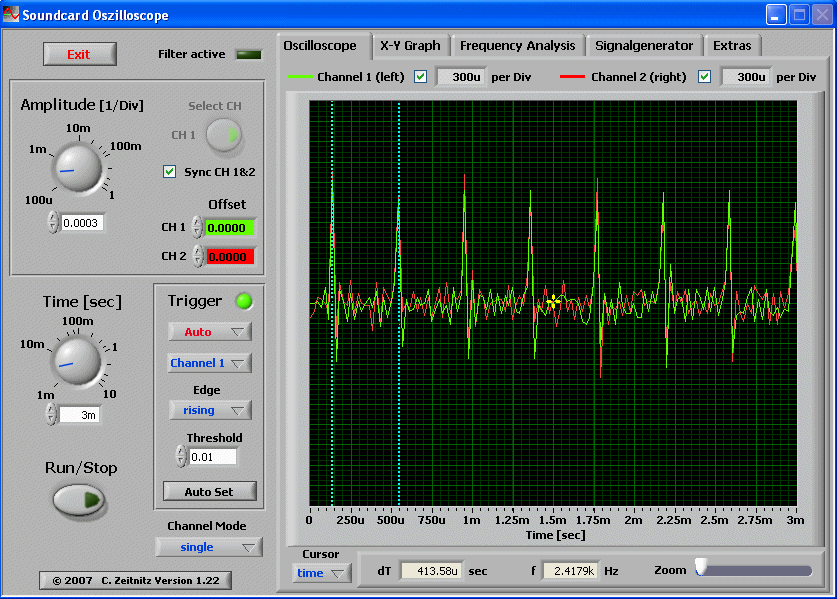
Like all multi-mode lights in this class, the Minis use pulse-width-modulation (PWM) for their Lo/Med modes. However, the PWM frequency is high enough at ~2.42 kHz that you will not notice it regular use, unless you really go looking for it. This is the same frequency as the 4Sevens Preons. Interestingly, it also the same exact same freq to what I obtained for the new ITP A1/A2 lights …
Testing Method: All my output numbers are relative for my home-made light box setup, a la Quickbeam's flashlightreviews.com method. You can directly compare all my relative output values from different reviews - i.e. an output value of "10" in one graph is the same as "10" in another. All runtimes are done under a cooling fan, except for the extended run Lo/Min modes (i.e. >12 hours) which are done without cooling.
Throw values are the square-root of lux measurements taken at 1 meter from the lens, using a light meter.
Throw/Output Summary Chart:
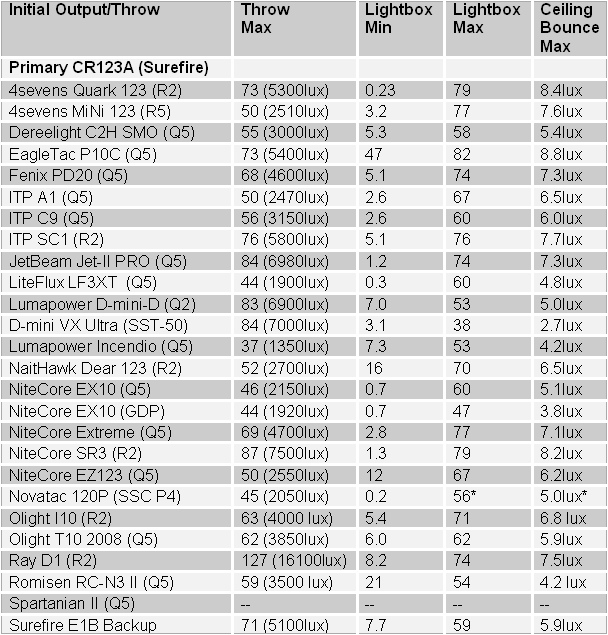
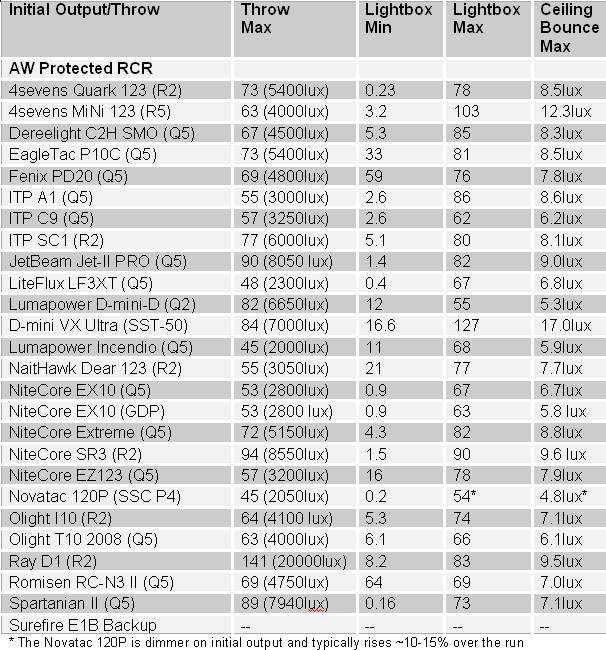
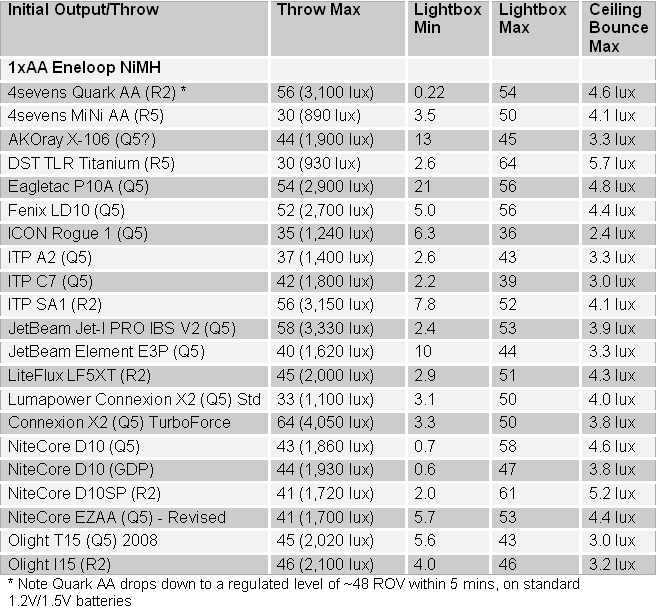
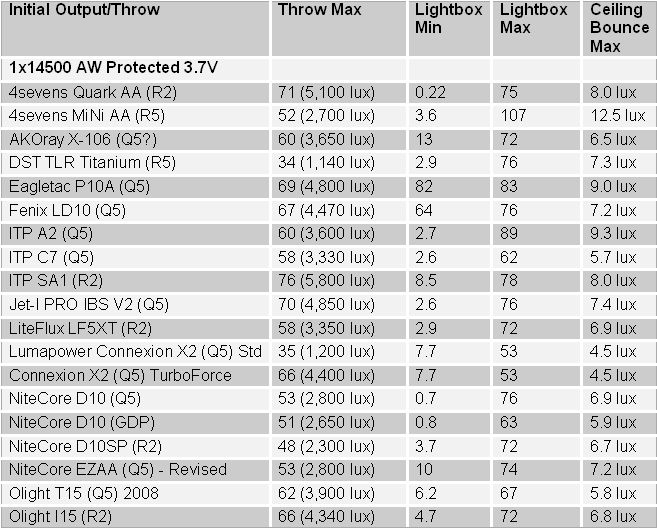
On standard primary batteries, the Minis strike a good balance between output and runtime (i.e. in keeping with their small size, they are not exactly maximally driven). It's a different matter on 3.7V Li-ion – on both 1xRCR and 1x14500, the Minis are real barn burners. Frankly, I don't consider these levels very safe for extended run – the lights will heat up very quickly.
Frankly, I don't consider these levels very safe for extended run – the lights will heat up very quickly.
As expected for XP-G emitters, throw is toward the low end for the relative overall output.
Lo mode is similar to other 3-stage lights.
Output/Runtime Comparison:
Let's start with the Mini 123 runtimes:
Note: Effective January 2010, all CR123A runtimes are now performed solely on Titanium Innovations batteries sponsored by BatteryJunction.com. You can compare the generally excellent performance of these CR123A cells relative to the Duracell/Surefire cells used in all my earlier reviews here. I have marked all the new runtimes of lights with Titanium Innovations CR123As on the graphs with an "*".
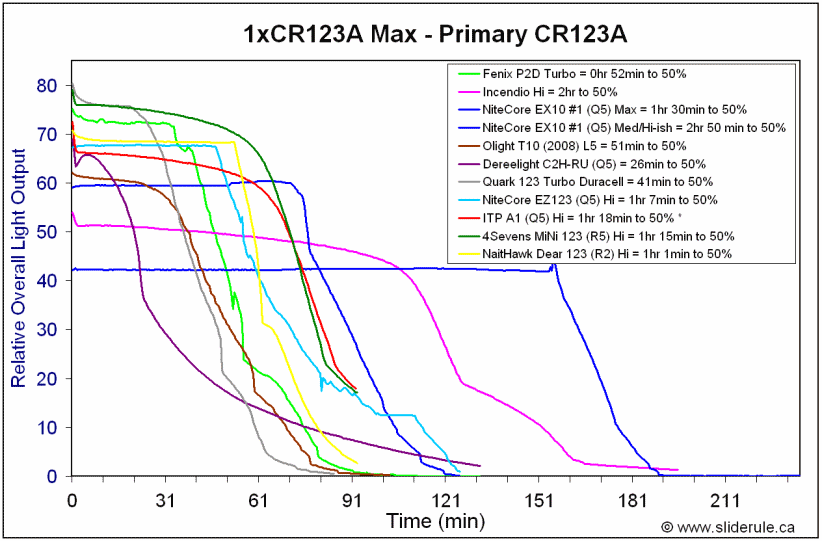
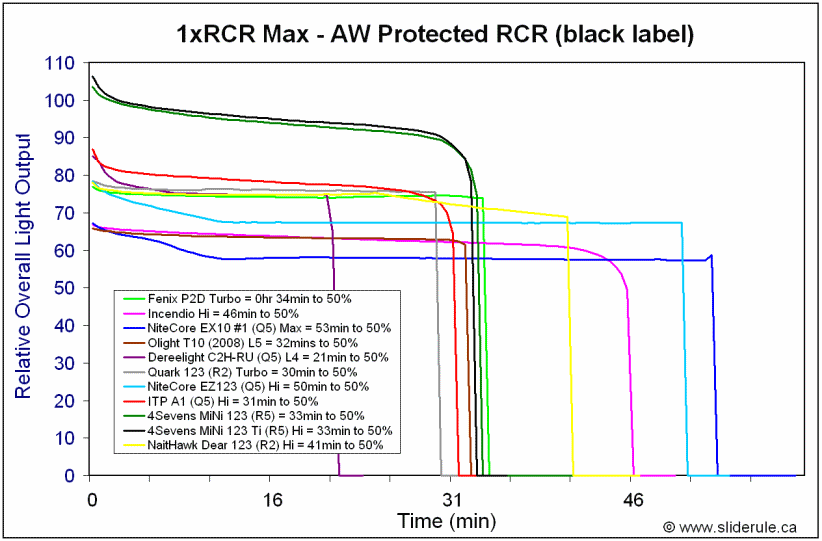
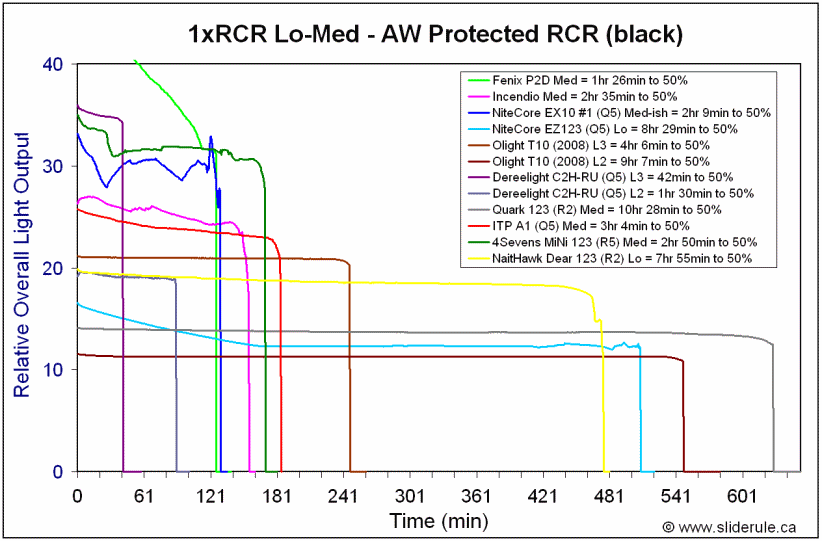
And now the Mini AA runtimes:
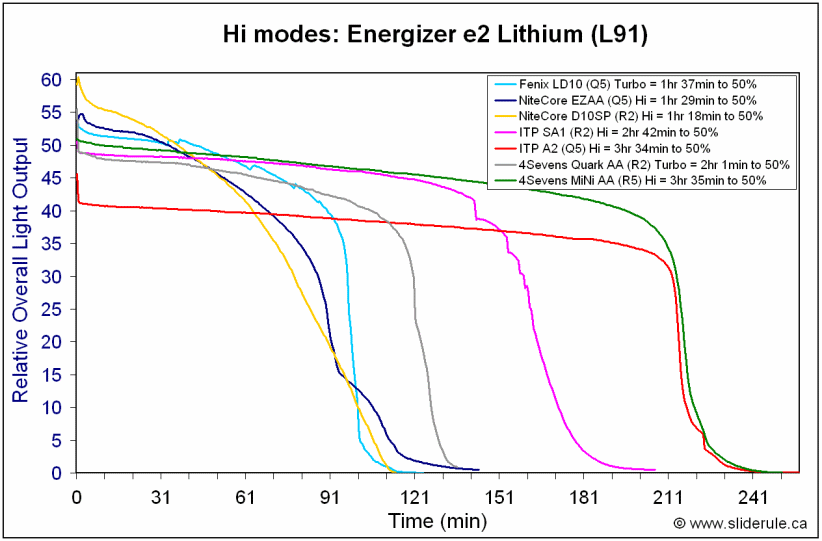
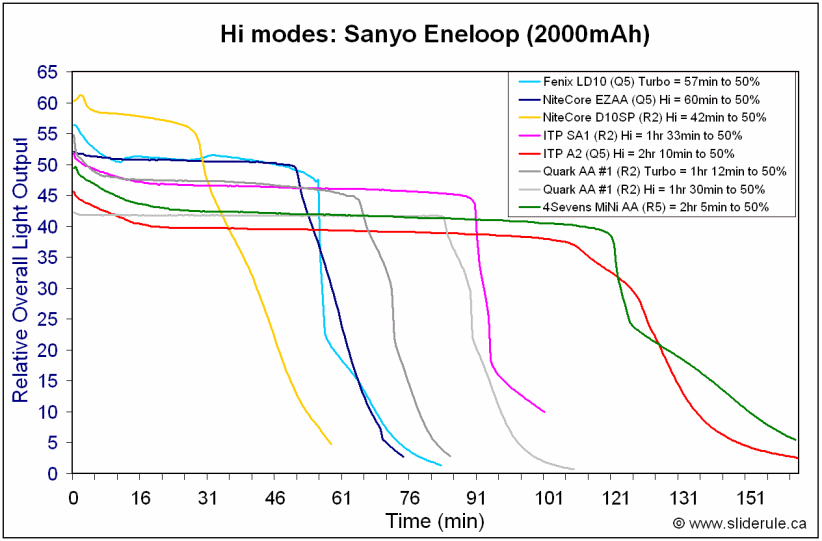
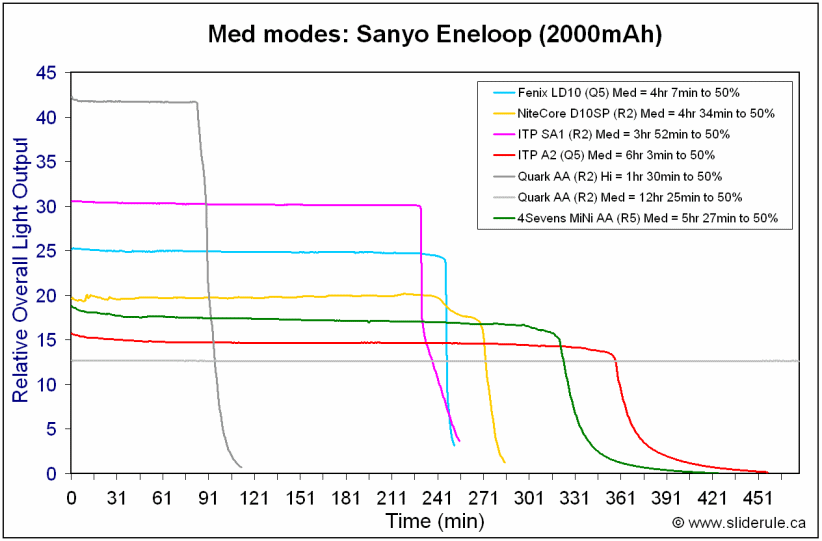
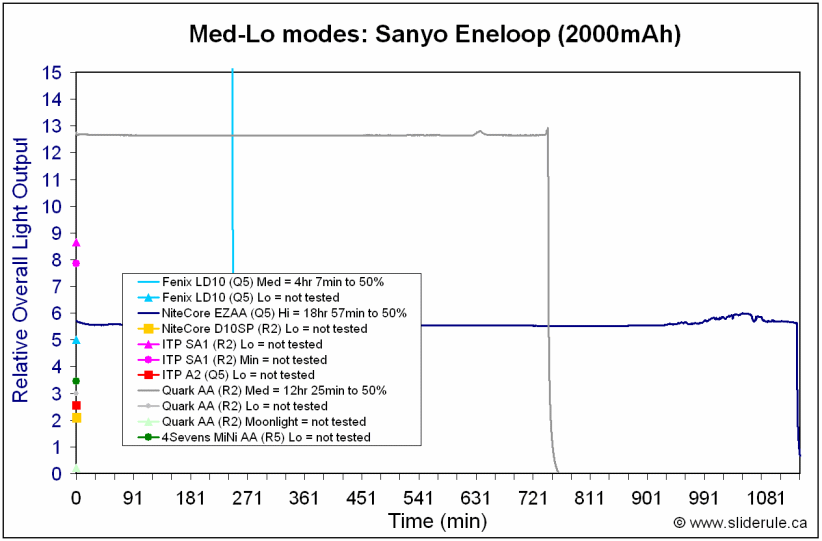
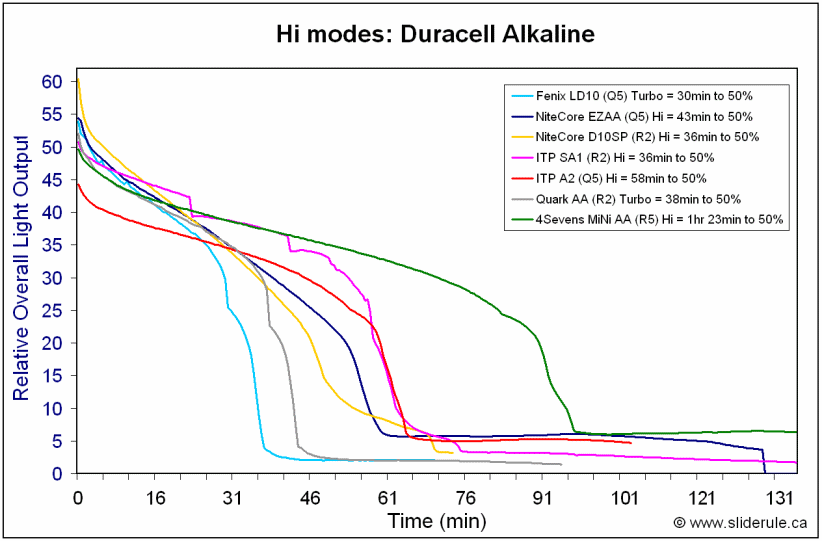
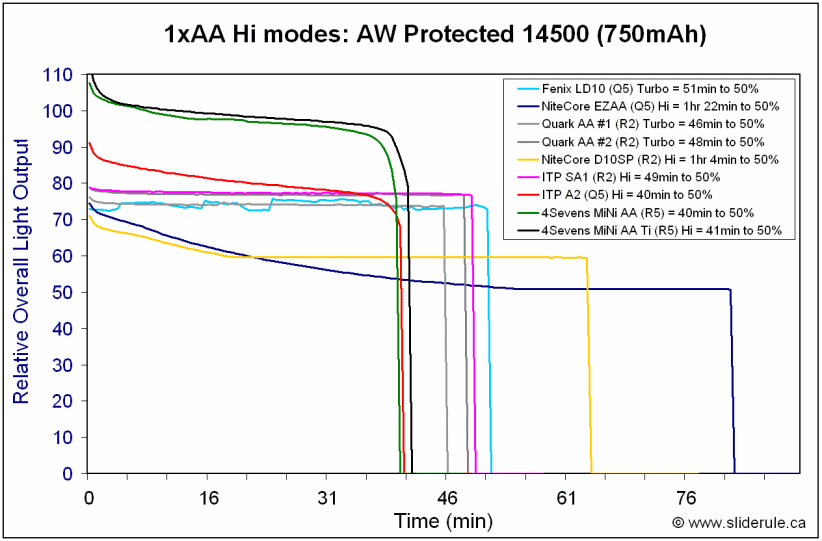
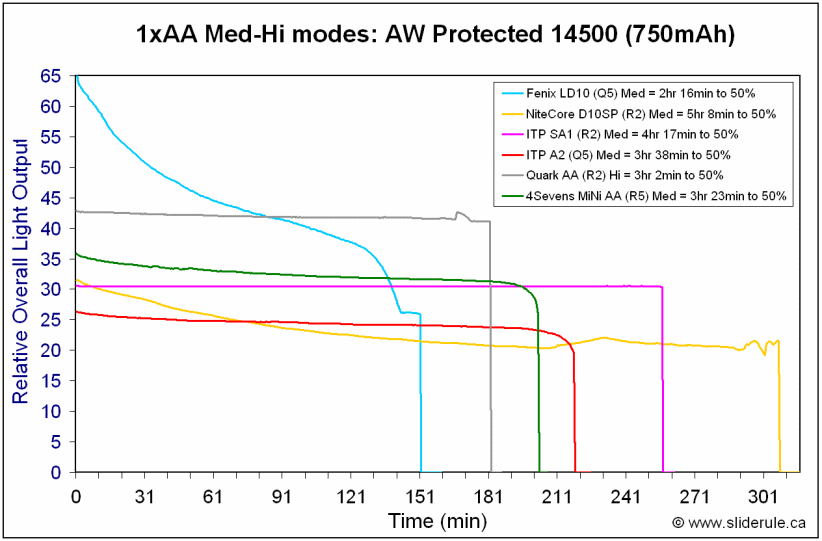
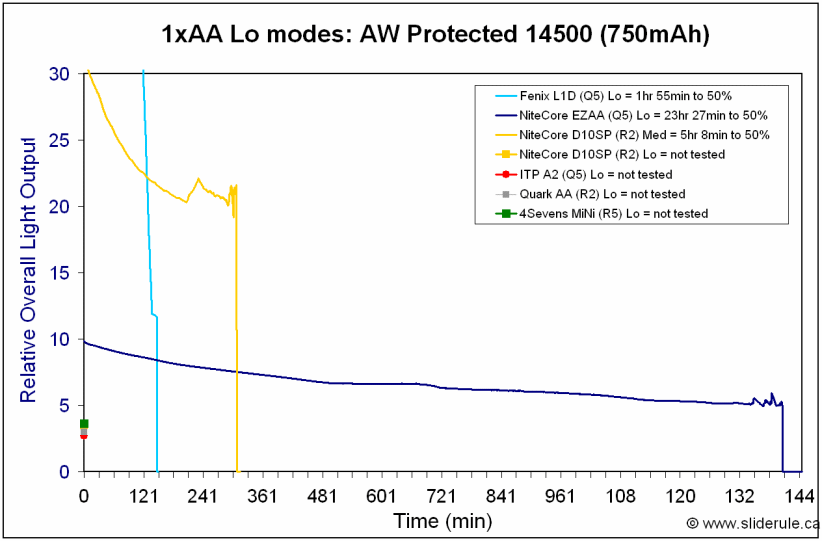
Ok, there's a lot of data up there. :sweat:
One immediate observation is that the circuit performance on all levels is virtually identical to the ITP A1/A2 lights. :thinking: When you take into account the R5 on the Minis vs the Q5 in the A1/A2, the runtimes could almost be superimpose-able. Coupled with identical PWM frequencies, it thus seems that it isn't only a physical build similarity that they share – the basic operation circuit mode is identical. oo:
oo:
Output/runtime efficiency on the Medium output setting is ok, but typically not as high as more expensive lights (or the regular Quark series).
UPDATE: For some comparison runtimes of the new Neutral and Warm White versions of the Mini AA and Mini 123, please see my new Mini Tint Comparison Review.
Potential Issues
Body wall construction is fairly thin, in keeping with a budget build. Although not at as great a risk of crushing as 1xAAA lights, I would still be careful with the aluminum Minis (i.e. try to not sit on them ).
).
Max output on 1x3.7V Li-ion (i.e. 1xRCR or 1x14500) is way too high for such a small build light. I recommend you do not run these lights on max on this battery source – or limit yourself to short periods of time only.
Preliminary Observations
The KISS 1xAAA form-factor recently took the flashlight world by storm (e.g. ITP A3, 4Sevens Preon). As a result, it's not surprising to see 1xCR123A and 1xAA offerings following along, using a similar design approach (e.g. ITP A1/A2, 4Sevens Mini series).
Like the 4Sevens Preon series, the Minis similarly take the small size and KISS interface a step further, with additional features (i.e. hidden special feature modes) and choice of materials (i.e. aluminum or titanium). Although not reviewed here, I understand 4Sevens has since released a 1xCR2 lights under the Mini family.
Build-wise (as simple twisty mechanisms go), there's not much more I would ask from the Minis. Personally, I like the minimalist style, and am glad to see the tailstanding, tail spring, and aggressive knurling. IMO, this later point is one of the main advantages of the Minis over the Preons (i.e. one-handed operation is a lot easier) – even if they aren't quite as stylish as the Preons.
I also like the use of the XP-G emitter, with the high output R5 bin. IMO, the smooth hotspot is great for general purpose EDC use. Note that throw is typically lower on XP-G lights, so don't expect major throw from these tiny offerings.
Like their 1xAAA brethren, choice of output levels are reasonable, with one exception - 1x3.7 Li-ion is WAY too bright on Hi. I note that this battery source (i.e. 1xRCR or 1x14500) is not officially supported by 4sevens. Nevertheless, it is commonly used by many members here so, so my warning persists – I do not recommend you run these lights on Hi on 1xRCR/14500 for any length of time. Efficiency of the Medium mode is also slightly lower than typical for their respective classes of light.
I note that this battery source (i.e. 1xRCR or 1x14500) is not officially supported by 4sevens. Nevertheless, it is commonly used by many members here so, so my warning persists – I do not recommend you run these lights on Hi on 1xRCR/14500 for any length of time. Efficiency of the Medium mode is also slightly lower than typical for their respective classes of light.
One interesting observation – although the Preons were a significant design change from other simple twisty 1xAAA lights (e.g. ITP A3), their overall performance was in keeping with lights of this class (once you took the different output bins into account). An even greater similarly in performance can be seen here for the Minis (i.e. equivalent basic circuit performance to the ITP A1/A2, but with a much higher output bin). Build-wise, the difference between the Minis and the budget ITP A1/A2 is reminiscent of the Maractac/ITP A3 difference. Of particular note – the heads and bodies of the Minis are interchangeable with the ITP A1/A2.
The Minis are certainly very nice offerings in this class of light. Although I don't usually comment on price, they are also quite competitive (especially with the CPF discount ), considering all that you get in the package.
), considering all that you get in the package.
UPDATE May 27, 2010: For a discussion of the possible tint options for the Mini line (i.e. Cool White, Neutral White, Warm White), please see my new Mini Tint Comparison Review.
UPDATE May 28, 2010: A separate review of the new Mini CR2 has just been posted.
Warning: Even more pic heavy than usual.
Manufacturer's specifications, condensed from their 4sevens.com:
- LED: CREE XP-G R5
- Max Output: 123: 189 OTF lumens, AA: 90 OTF lumens
- Material: Type-III Hard-anodized Aircraft-grade Aluminum
- Lens: Optical-grade glass lens with anti-reflective coating on both sides
- Water resistance: IPX-8
- Battery: 123: 1xCR123A (3V max); AA: 1xAA (1.5V max)
- Seven Output Modes:
- Low: 123: 3 OTF lumens, 150 hours; AA: 2.7 OTF lumens, 60 hours
- Medium: 123: 40 OTF lumens, 8 hours; AA: 25 OTF lumens, 8 hours
- High: 123: 189 OTF lumens, 1.2 hours; AA: 90 OTF lumens, 1.3 hours
- Special (hidden) modes:
- Strobe: 123: 2.4 hours; AA: 4 hours
- SOS: 123: 7.2 hours; AA: 12 hours
- Beacon (Hi): 123: 12 hours; AA: 20 hours
- Beacon (Lo): 123: 60 hours; AA: 100 hours
- Dimensions:
- Length: 123: 2.3 inches; AA: 3.0 inches
- Diameter: 123: 0.80 inches; AA: 0.70 inches
- Weight (w/o battery): 123: 0.62 ounces; 123 Ti: 0.9 ounces; AA: 0.67 ounces; AA Ti: 0.8 ounces
- MSRP: $39 for aluminum versions, $69 for Ti versions


Each light comes in an identical good-quality presentation case, similar to a medium-sized jewelery box (i.e. solid lid with hinge). Inside, you find the light well packaged inside white cut-out foam, along with a battery (Duracell AA or 4Sevens CR123A, as appropriate), good quality wrist strap/lanyard, and manual
To keep this simple, I will alternate between representative pics of the various samples below. Construction is generally equivalent between all the specimens, so my comments apply equally to each member of the Mini family. This will save me from having to take a gazillion photos ... :sweat:







From left to right: Surefire CR123A, 4Sevens MiNi 123, ITP A1, NaitHawk Dear 123, Nitecore EX10, 4Sevens Quark 123, Novatac 120P, 4Sevens MiNi Titanium 123.

From left to right: Duracell AA, 4Sevens MiNi AA, ITP A2, NiteCore D10, DST TLR Titanium, 4Sevens Quark AA, 4Sevens MiNi Titanium AA.
As you can see, the lights are indeed quite small for their respective classes. Basically, you don't get much smaller than this! Like the popular 1xAAA series 4Sevens Preon and ITP/Maratac lights, the aluminum body construction seems thin (i.e. body walls), but is still serviceable. The titanium versions are of course more sturdy, due to the source material used.
The Minis have the advantage of generous knurling, which makes it easier to use the twist feature one-handed. :thumbsup: Knurling is fairly aggressive – on both the aluminum and titanium versions. I didn't notice any chips or damage in the finish on any of my samples. The finish of the titanium versions is somewhat shiny (i.e. high gloss polished).



In keeping with the minimalist build, the head has a simple contact board (which just happens to look an awful lot like the ITP A1/A2 ...
Note that the threads were somewhat "gritty" on several of my samples. Although this didn't interfere with operation, I recommend you clean them thoroughly upon arrival (and maybe even apply a small amount of a good quality non-conducting lube). Note also that titanium lights typically suffer from some degree of "galling" in the screw threads (i.e. a sticky/binding sensation - this is normal).
The lights all use a removable spring for the negative contact, which should reduce the risk of accidentally crushing a cell. :thumbsup:


The lights can tailstand, and there is thoughtfully an attachment point for a lanyard. :thumbsup:




The lights feature one of the latest edition Cree emitters - the XP-G (R5 output bin, no tint bin specified). Reflector is not overly deep, but heavily textured.
And now for the requisite white wall hunting






And now the 1xAA lights, on Sanyo eneloop, about 0.5 meters from a white wall:



As expected, beam pattern is fairly good for a general purpose light. Don't expect massive throw from an XP-G. Tint was generally slightly on the yellow-green side of cool white (i.e. not a premium output bin). :shrug: For those of you not familiar with tint bins, please see my Colour tint comparison and the summary LED tint charts found here.
As an aside, you will note the strong beam pattern similarity to the ITP A1/A2 lights. It's a little more than that – if you check out my review of those lights, you will see they share an almost identical build with the Minis. Sure, the Minis have a different lanyard attachment and aggressive knurling, but the difference to the A1/A2 is very much similar to the Maratac compared to the ITP A3. In fact, the head/body tubes are interchangeable between the Minis and ITP A1/A2 …
UPDATE: Note that the standard Cool White Minis are shown above. For a discussion of the possible tint options for the Mini line (i.e. Cool White, Neutral White, Warm White), please see my new Mini Tint Comparison Review.
User Interface
The Minis use the same interface as the AAA 4Sevens Preons. In their standard operating mode, they are very similar to other budget lights (e.g. ITP/Maratac), and use a Lo > Med > Hi mode sequence. However, like the Preons, the Minis have a few additional tricks up their battery tubes ….
Basic operation is controlled by twisting the head tight against the body to activate the light, loosen to turn off. Do a twist off-on in under 1 sec and the light advances to its next mode sequence. Wait more than two seconds before re-activating the light after turning off, and it returns to default Lo (i.e. no memory mode).
There is no strobe or SOS mode to worry about in the regular interface. :kiss: But like the Preons, they are "hidden" away if you want them. Normally, twisty-mode cycle selection continues indefinitely - keep doing off-on twists to run through all the sequences in order again. But if you run through the complete sequence twice in under two seconds (i.e. On Lo > Med > Hi > Lo > Med > Hi), you will access the additional hidden modes. These present themselves in sequence as Strobe > SOS > Hi Beacon > Lo Beacon.

Like the Preons, strobe was measured at 10Hz. Beacon modes are 5 rapid flashes followed a single ~1.25 sec flash at 10 sec intervals, at either full power (Hi) or lower power (Lo).
Note that there is no memory for "special outputs" either – if you turn off the light for more than 2 seconds, you will be back at constant output Lo when next you re-illuminate. So no worries about getting stuck accidentally strobing yourself here. :thumbsup: Frankly, this is the sort of interface I like to see – "special modes" are well hidden, and not at all obtrusive.

Like all multi-mode lights in this class, the Minis use pulse-width-modulation (PWM) for their Lo/Med modes. However, the PWM frequency is high enough at ~2.42 kHz that you will not notice it regular use, unless you really go looking for it. This is the same frequency as the 4Sevens Preons. Interestingly, it also the same exact same freq to what I obtained for the new ITP A1/A2 lights …
Testing Method: All my output numbers are relative for my home-made light box setup, a la Quickbeam's flashlightreviews.com method. You can directly compare all my relative output values from different reviews - i.e. an output value of "10" in one graph is the same as "10" in another. All runtimes are done under a cooling fan, except for the extended run Lo/Min modes (i.e. >12 hours) which are done without cooling.
Throw values are the square-root of lux measurements taken at 1 meter from the lens, using a light meter.
Throw/Output Summary Chart:




On standard primary batteries, the Minis strike a good balance between output and runtime (i.e. in keeping with their small size, they are not exactly maximally driven). It's a different matter on 3.7V Li-ion – on both 1xRCR and 1x14500, the Minis are real barn burners.
As expected for XP-G emitters, throw is toward the low end for the relative overall output.
Lo mode is similar to other 3-stage lights.
Output/Runtime Comparison:
Let's start with the Mini 123 runtimes:
Note: Effective January 2010, all CR123A runtimes are now performed solely on Titanium Innovations batteries sponsored by BatteryJunction.com. You can compare the generally excellent performance of these CR123A cells relative to the Duracell/Surefire cells used in all my earlier reviews here. I have marked all the new runtimes of lights with Titanium Innovations CR123As on the graphs with an "*".



And now the Mini AA runtimes:








Ok, there's a lot of data up there. :sweat:
One immediate observation is that the circuit performance on all levels is virtually identical to the ITP A1/A2 lights. :thinking: When you take into account the R5 on the Minis vs the Q5 in the A1/A2, the runtimes could almost be superimpose-able. Coupled with identical PWM frequencies, it thus seems that it isn't only a physical build similarity that they share – the basic operation circuit mode is identical.
Output/runtime efficiency on the Medium output setting is ok, but typically not as high as more expensive lights (or the regular Quark series).
UPDATE: For some comparison runtimes of the new Neutral and Warm White versions of the Mini AA and Mini 123, please see my new Mini Tint Comparison Review.
Potential Issues
Body wall construction is fairly thin, in keeping with a budget build. Although not at as great a risk of crushing as 1xAAA lights, I would still be careful with the aluminum Minis (i.e. try to not sit on them
Max output on 1x3.7V Li-ion (i.e. 1xRCR or 1x14500) is way too high for such a small build light. I recommend you do not run these lights on max on this battery source – or limit yourself to short periods of time only.
Preliminary Observations
The KISS 1xAAA form-factor recently took the flashlight world by storm (e.g. ITP A3, 4Sevens Preon). As a result, it's not surprising to see 1xCR123A and 1xAA offerings following along, using a similar design approach (e.g. ITP A1/A2, 4Sevens Mini series).
Like the 4Sevens Preon series, the Minis similarly take the small size and KISS interface a step further, with additional features (i.e. hidden special feature modes) and choice of materials (i.e. aluminum or titanium). Although not reviewed here, I understand 4Sevens has since released a 1xCR2 lights under the Mini family.
Build-wise (as simple twisty mechanisms go), there's not much more I would ask from the Minis. Personally, I like the minimalist style, and am glad to see the tailstanding, tail spring, and aggressive knurling. IMO, this later point is one of the main advantages of the Minis over the Preons (i.e. one-handed operation is a lot easier) – even if they aren't quite as stylish as the Preons.
I also like the use of the XP-G emitter, with the high output R5 bin. IMO, the smooth hotspot is great for general purpose EDC use. Note that throw is typically lower on XP-G lights, so don't expect major throw from these tiny offerings.
Like their 1xAAA brethren, choice of output levels are reasonable, with one exception - 1x3.7 Li-ion is WAY too bright on Hi.
One interesting observation – although the Preons were a significant design change from other simple twisty 1xAAA lights (e.g. ITP A3), their overall performance was in keeping with lights of this class (once you took the different output bins into account). An even greater similarly in performance can be seen here for the Minis (i.e. equivalent basic circuit performance to the ITP A1/A2, but with a much higher output bin). Build-wise, the difference between the Minis and the budget ITP A1/A2 is reminiscent of the Maractac/ITP A3 difference. Of particular note – the heads and bodies of the Minis are interchangeable with the ITP A1/A2.
The Minis are certainly very nice offerings in this class of light. Although I don't usually comment on price, they are also quite competitive (especially with the CPF discount
Last edited:


 Quite the battery vampire.
Quite the battery vampire. . Still, should be perfectly safe on Lo/Med, I would think.
. Still, should be perfectly safe on Lo/Med, I would think.